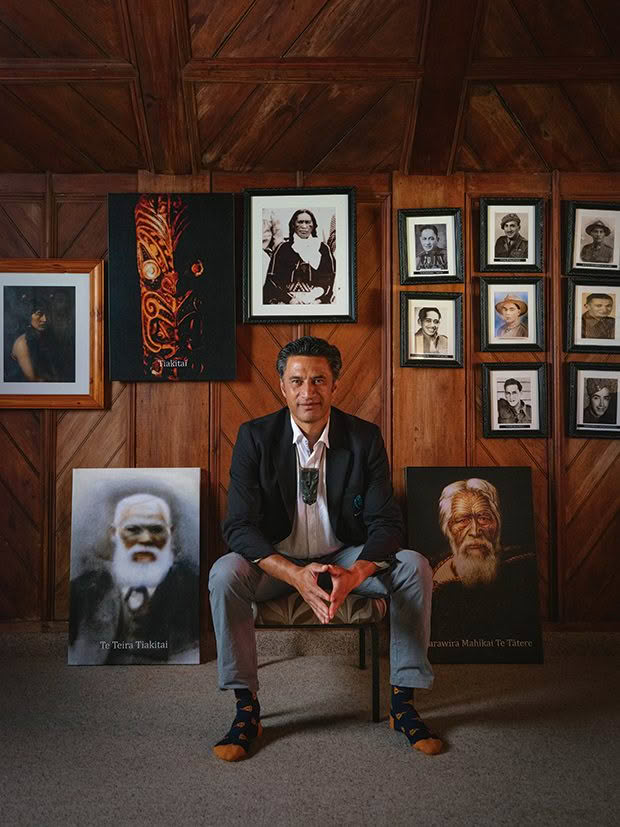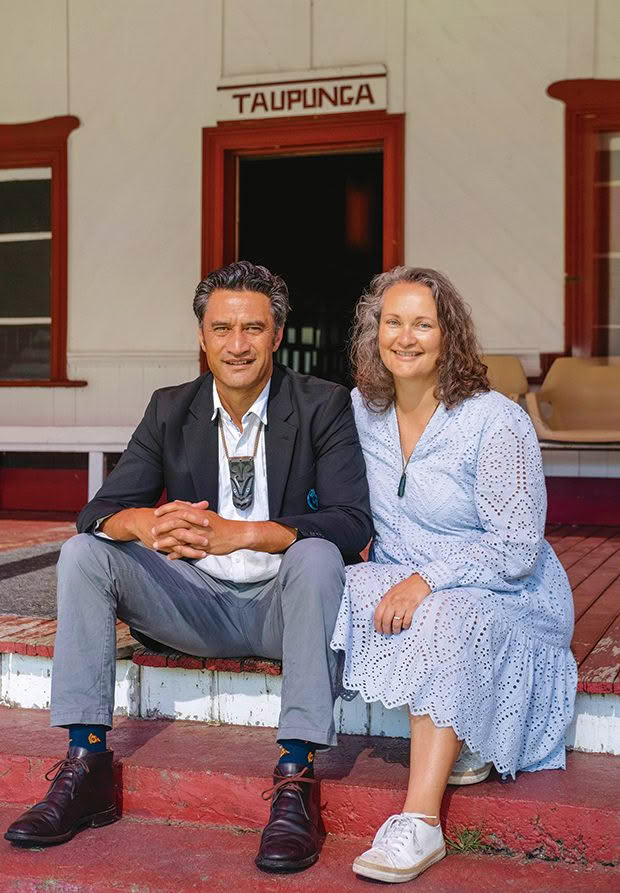Bayden Barber ensures that the legacies of his ancestors are embedded in his iwi

Bayden Barber’s path to a significant tribal leadership role was inevitable, given the influence of his elders on his upbringing.
Words: Amokura Panoho Photos: Florence Charvin
PEPEHA
Ko Te Whanganui-a-Tara te maunga
Ko Waingōngoro te awa
Ko Waimārama te marae
Ko Taupunga te whare
Ko Tiakitai te tangata
Ko Ngāti Kurukuru te hapū
Ko Tākitimu te waka
Ko Ngāti Kahungunu, Ko Ngāpuhi,
Ko Ngāi Tahu ōku iwi.
Whanganui-a-Tara is my mountain
Waingōngoro is my river
Waimārama is my marae
Taupunga is my wharenui
Tiakitai is my ancestor
Ngāti Kurukuru is my hapū
Tākitimu is my waka
Ngāti Kahungunu, Ngāpuhi and
Ngāi Tahu are my iwi.
Bayden Barber owns the consultancy company Wana Consulting with his wife, Myra. He holds governance roles on Māori land trusts and Māori health trusts within his rohe (region). He was re-elected to the Hastings District Council in 2019 and became the deputy chair in 2020 of Te Maruata Executive Committee within Local Government NZ. He is a commissioner for Te Taura Whiri i te Reo Māori (the Māori Language Commission), a recent trustee of Te Mata Park Trust and an independent director of Beef + Lamb NZ. In 2022, he was elected as the chair of Ngāti Kahungunu Iwi Incorporated, the mandated iwi organisation to manage the iwi fisheries settlement.
HOW HAS YOUR JOURNEY IN LIFE SHAPED YOU?
I am a descendant of Tiakitai, the paramount chief of the Waimārama region, renowned for maintaining continuous occupation of those lands for Ngāti Kahungunu during the Musket Wars, and my leadership pathway has come through flax-roots marae-based kaupapa. My upbringing was very Waimārama-centric. My maternal grandmother Haumihia Te Whaiti (from the Wairarapa) married my grandfather Te Rongomau Tiakitai, a 28th Māori Battalion veteran. She was very staunch about how you carried yourself and represented your people at a hapū level. I grew up around those elders, and my politics and my worldview, has been shaped by their kōrero.
There was an expectation that I would be a leader for our people, and I have been supported right throughout my childhood. You go through that pathway at a marae level, at a hapū level, and if you’re in that environment, iwi issues are always at the forefront of those discussions. Though it started with marae and hapū leadership roles, it has since broadened to the wider community after being elected to the Rural Community Board for the Hastings District Council. Living in a rural community, I was always vocal at public meetings about better water, better roading and better schooling for our children. In 2016, I stood for the Hasting District Council.
It was an interesting time as the election occurred a year after the Havelock water crisis, where our community suffered badly. In this day and age, water making people sick is unacceptable. We knew about the aquifer that flows under the Heretaunga Plains, the food bowl of Aotearoa. Te mana o te wai (the vital importance of water) was a kōrero we were talking about back then, so I stood on a platform for better water quality. I won in a general seat where the constituency was predominantly wealthy and middle-class Pākehā. Water is an issue that transcends race and class.
Once in that role, I brought forward my te aō Māori (Māori worldview) viewpoint. When I stood and successfully became the chair for the iwi in April 2022, the experience and profile of being in local government, as well as a term as vice-president of the Māori Party, helped me prepare. Going up against the sitting incumbent Ngāhiwi Tomoana, who had been in the role for 26 years, known not just in Hawke’s Bay but nationally as a tribal leader, was a challenge I did the groundwork for.
WHAT ARE YOUR GOALS FOR YOUR PEOPLE?
Essentially, my goal is to maintain the legacy left for our people by our ancestors and to ensure that our iwi is thriving as a people, as individuals, as whānau. Our reo and our tikanga, our marae, are thriving — excelling in their jobs and with good career prospects. They are not just successful academics, businesspeople, professionals and doctors, but they have those prosperous careers while being fluent in our reo, being connected to their whakapapa, to their marae. They lead by example and ensure we are good role models for our tamariki (children).
We are one of the biggest iwi in terms of population and geographic location and that has led to challenges, with our various settlements negotiated through different entities within our tribe, negotiating on their own mana motuhake (independence), which has resulted to date with seven post-settlement entities and six taiwhenua (regions). The Crown process for settlement has created a lot of division between us, with different expectations and understandings of our tribal history and authority.
I campaigned for the iwi chair role to create greater cohesion, to achieve kotahitanga. If we bring that strength together without duplicating our efforts, we can have significant political, social and economic clout.
Probably the biggest challenge I face as chair is how we stitch that all back together. It is fine to talk mana motuhake, but sometimes we need to be one strong collective. Cyclone Gabrielle has been a prime example of where we need to take a kotahitanga approach. The number of meetings I have had to attend over the past few weeks with central and local government ministers and officials has demonstrated to me how easy it would be to get overwhelmed and undermined by their bureaucracy and face another level of disenfranchisement in the recovery process. Together we are stronger.
HOW WILL THESE ASPIRATIONS BE ACHIEVED?
Housing and water infrastructure are key issues for our people, who lack affordable and public housing. In 2019, we identified a housing crisis, so we pushed through a Hastings housing strategy, which became the model for the country, bringing together iwi, settlements groups, the Ministry of Housing and Urban Development, Te Kainga Ora, Te Puni Kōkiri and the Hastings District Council. This gave us a head start compared with other regions like Rotorua, and we have been building houses ever since.
Our combined settlement quantum for our rohe (region) is probably the largest in the country. We are collectively at over $500 million, with some of our taiwhenua organisations, especially in health, operating annual turnovers of $50 million.
We have started by bringing our post-settlement groups together to look at common interests and opportunities so we can create scale and leverage for things like the recovery effort, rebuilding infrastructure, home ownership and land diversification.
There are ways for our various mana motuhake entities to co-exist.
There is a whakataukī (proverb) He tōtara wāwāhi rua he kai nā te ahi/A tōtara split in half is only good for firewood. We must take lessons from our ancestors, like during the Musket Wars, when we moved together to protect ourselves from the northern tribes who were invading our territory. If we hadn’t come together, we would’ve been picked off and been part of the fires. We had the Kotahitanga Māori parliament during the late 1800s as part of our history, so we are not strangers to unity and kotahitanga.

WHO AND WHAT WERE THE MOST FORMATIVE INFLUENCES IN YOUR LIFE?
My wife, Myra. Without her, I wouldn’t be able to do what I do. We met at Waikato University, where we completed our Bachelor of Management Studies. “She was way smarter than [everyone] at uni, and nothing’s changed.” Together, with our children and now mokopuna, she is my backbone.
In the late 1980s, as a student at Tauhara College, Taupō, where I lived for a while, one of my teachers was Te Ururoa Flavell. This was a time before graduates were coming out of kōhanga reo and kura kaupapa. He introduced me to the importance of excelling at school, using te reo Māori as a platform for bringing young leaders through the education system. I credit him with putting me on the right path and for making me value the strong cultural environment I had at home in Waimārama.
Also, at home, we had Tā (Sir) Timoti Kāretu as a kaumātua (elder) for our marae, a renowned authority on te reo Māori. He has led our marae community on a language journey since 2002 as part of a 25-year strategy, and I have been part of that, with the likes of Dr Jeremy Tātere McLeod.
My mother, Marama Tiakitai, is also still teaching at Waimārama kōhanga reo, alongside my father, Edward Barber (Ngāpuhi, Ngāti Kahungunu). I might be an iwi chair, but when I go back to my marae, I am still told by my kuia what’s what.
The mayors I have served alongside — Lawrence Yule and Sandra Hazelhurst — have been huge influences and supporters. And in wider te ao Māori leadership, Tukoroirangi Morgan; having that tautoko (support) from the Kiingitanga and a whakapapa connection. Also, Uncle Jerry Hapuku (MNZM) is a huge influence and one of our key kaumātua here in Ngāti Kahungunu.
YOUR ADVICE FOR INTERESTED READERS?
Recognise that our history is complex and that the structures that have emerged from the settlement process reflect that complexity. Learning that history will be a valuable experience. Māori are here to stay. We have the fastest-growing youth demographic in Aotearoa, so our future is with them. My role is to ensure a pathway to leadership for our Ngāti Kahungunu rangatahi and help build their kete mātauranga, filling it with the skills and experience needed to achieve success. The whakataukī given to our Waimārama people from Tā Tīmoti Kāretu is very applicable, “Kei noho wawata noa… kia eke!”/“Don’t let it remain a dream… go get it!”
TREATY SETTLEMENT HISTORY
Geographically, Ngāti Kahungunu has the second-largest tribal rohe (region) in the country, from the Wharerātā Ranges in the Wairoa District to the Remutaka Range in South Wairarapa. The coastal boundaries are from Paritū, north of Te Māhia, to Tūrakirae on the South Wairarapa coast.
Given the geography of Ngāti Kahungunu, the iwi is divided into six taiwhenua (districts), which incorporate 87 marae and more than 100 hapū. About 85,000 people identify as members of the third largest iwi population in Aotearoa, at 9.2 per cent of the Māori population.
At a hui at Kohupātiki in 1988, a three-tier claims process was established:
The iwi has its own economic autonomy and development;
Hapū have their own autonomy and development;
Whānau are independent with their own economic trajectory.
This became the major kaupapa (focus) for Ngāti Kahungunu and its leaders.
The first tier saw Ngāti Kahungunu achieve economic autonomy and development through the 2006 fisheries settlement. The quantum was $31 million, consisting of $29 million shares in quota and $2 million in cash.
Since then, the balance sheet has more than tripled.
For the second tier, the iwi dedicated all land claims to clusters of hapū, of which there were eight claims, including with estimated settlements: Wairoa ($100 million), Ngāti Pāhauwera ($20 million), Ngāti Hineuru ($25 million), Maungaharuru Tangitū ($23 million), Mana Ahuriri ($19.5 million), Heretaunga Tamatea ($100 million), and Ngāti Kahungunu ki Wairarapa Tāmaki Nui a-Rua Trust ($165 million), bringing a total into the rohe of $452.5 million.
Post-settlement activity is premised on our three-tier process being realised as successful when we can achieve economic independence for our whānau.
Love this story? Subscribe now!
 This article first appeared in NZ Life & Leisure Magazine.
This article first appeared in NZ Life & Leisure Magazine.
